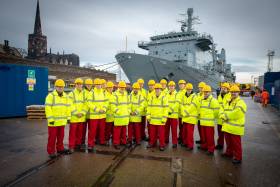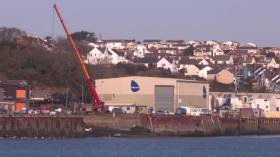Displaying items by tag: UK Shipyard
UK Shipyard On Merseyside Recruits 20 Apprentices Taking Investment to £19 Million
In the UK along Merseyside is shiprepairer, shipbuilder, and engineering services company Cammell Laird which has recruited 20 new apprentices to its workforce.
The famous shipyard on Birkenhead, says it has completed the most rigorous recruitment process ever undertaken with the 20 recruits starting their four-year apprenticeship this autumn at a cost of £250,000-a-year and £1million in total.
Cammell Laird chief operating officer Tony Graham said the new starters will take the total number of apprentices recruited into the business to 270 since 2008 with an ambition to take on 20 more every year. To date the company has invested more than £18million in its apprentice programme making it one of the biggest in the UK maritime industry and Northern Powerhouse region. The latest in-take will take the investment to £19million.
“We warmly welcome our new apprentices to their roles,” he said. “The sky is the limit for apprentices here at Cammell Laird with many of our senior management including myself and our CEO John Syvret starting their careers as an apprentice. The message we want to give young people, their parents, schools and colleges is that an apprenticeship offers as much opportunity as a university degree. At Cammell Laird you can start your career learning on the job, giving you the skills and training required for a high achieving career. You can become productive quickly and you will be financially better off than many young people going to university as you are effectively being paid to learn rather than having to get into debt. Then the apprenticeship is designed to secure a well-paid skilled job on completion with the company. We should also emphasize that by joining Cammell Laird you can help make a genuine difference to our community. Cammell Laird’s success helps underpin job and wealth creation on Merseyside and we’ve been able to generate £350million for the local and UK economy since 2013 employing 1500 direct and indirect workers and 300 small business suppliers at peak times.”
Mr Graham said this year’s in-take is drawn from the Merseyside region and is aged between 16 and 27.
“We want to issue a positive message built around Cammell Laird’s future order book with customers like the Royal Fleet Auxiliary, the Royal Navy and BAE Systems – we have lots of work over the next ten years (see work pipeline below),” he said. “But there is a skills gap on Merseyside and in the maritime industry. We cannot find all the people and skills we need so we are having to invest into training the next generation hence why we really want schools to get behind the job opportunities here. We have shown by building the RRS Sir David Attenborough that Cammell Laird is back in the ‘premier league’ of shipbuilding, building iconic world-famous ships. And the new group of apprentices were able to board the new polar ship for the recent Royal ship naming with the Duke and Duchess of Cambridge which sent a very strong message to them about the opportunities they have at Cammell Laird. We urge more young people to follow our apprentices and think of a career in engineering and maritime and join us on our upward trajectory.”
Mr Graham said the new apprentices will be divided into mechanical fitters, pipefitters, platers and welders.
“We have been working with our partner the Engineering College, which neighbours the shipyard, on recruiting the apprentices who will now undertake their training at the college,” he said. “This was a thorough five-stage recruitment process that saw 100 people apply initially which was eventually reduced to the final 20 recruits. We looked at their educational achievements, community activities and then undertook a team-building day before staging interviews with the HR and production departments. We know a large number of those who just missed out, on being selected, will be able to come back next year stronger and stand a great chance of securing an apprenticeship with greater understanding of what we are looking for.”
UK Appledore Shipyard to Shut Putting 200 Jobs at Risk
#Ports&Shipping- The UK shipyard (that built LÉ George Bernard Shaw) is to shut despite its owner being offered a £60m contract by the MoD.
Staff at Appledore Shipyard in Devon reports BBC News have been told by owner Babcock that it will close by the end of March 2019.
The company recently lost a contract with the Armed Forces of Malta, causing financial difficulties.
Babcock said all 199 workers will be offered a move to Devonport Dockyard, also owned by the firm, 45 miles (72km) away.
'We want answers'
The GMB union said it wanted answers from the government and from Babcock about the £60m package which would have offered extra work at Devonport.
Babcock had said the extra work would not be enough to secure Appledore's future, see related report.
Some Appledore staff had been temporarily redeployed to Devonport since the news of the lost contract came through.
For more on "Save Appledore Shipyard" petition and a brief history of the facility dating to 1855, click here.































































